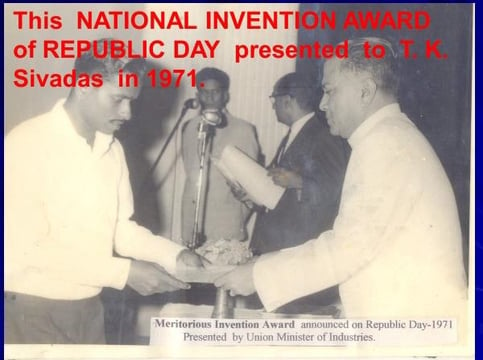Introduction
4/16/20244 min read


Figure 1: Prestigious National Award presented to T.K. Sivadas in 1971 by the Union Minister of Industries, Government of India, in New Delhi, for the R&D work on the development of the Operational-Depth Telemeter. This innovation enables the guidance and control of the underwater Otter Trawl System to the fish-depth, intercepting fish schools for better efficiency in mid-water trawl operations.




Figure 2: National Invention Award presented to T.K. Sivadas in 1976 by the President of India for the development of electronic instruments for the safe and efficient operation of the otter trawl system. This innovation led to many operational advantages, including safety of operation, better scope ratio estimation, and timely detection of damages to the underwater otter trawl system.
Figure 3: Shri Sreejith, T.S., Managing Director of EMCON (Environmental Measurements and Control-Cochin), receiving the MSME National Award for Research and Development instituted by the Ministry of Micro, Small and Medium Enterprises (MSME)- Government of India in 2007 at Delhi. This is the only award received from MSME by a Kerala entity under the category of Research and Development so far.




Figure 3A: Certificate of the National Award for Research & Development given to Shri T.S. Sreejith, Managing Director of EMCON, for the supply of rare instruments to many R&D institutes. This contribution enabled them to conduct numerous new investigations in open nature for the benefit of the country.
Bridging Physics and Electronics: Transformative Innovations in Natural Resource Management
Combining physics with electronics has revolutionized how we understand and manage natural processes. These advancements enable precise resource estimation and promote sustainable practices. With a robust background in physics and extensive involvement in numerous national R&D projects, Dr. T.K.Sivadas has made significant contributions, documented across 124 figures, benefiting various scientific fields.
Contributions
Pioneering Innovations by Dr. T.K. Sivadas
Dr. Sivadas has led groundbreaking inventions and large system designs that have significantly advanced multiple disciplines.
Establishment of EMCON
EMCON was founded to commercialize and implement these technological innovations, driving them from concept to widespread application.
Technology Implementation
Sreejith T.S., Managing Director of EMCON: Played a crucial role in deploying these technologies across over 700 R&D institutions.
Joshy T.D.: Contributed to early technology implementations before 2000.
Key Turning Points
Visionary Guidance
Inspired by Dr. A.N. Bose's concept of illustrated design, expanding from fishing technology to numerous other fields.
Widespread Recognition
The technologies, encompassing numerous inventions, have earned over 10 national and international awards.
Broad Application
Applied in diverse fields such as Agricultural Sciences, Ocean Technology, Fishing Technology, and more.
Applied Areas of Illustrated Analysis
Agricultural Sciences
Ocean Technology
Fishing Technology
Post-Harvest Technology
Behavior Studies of Marine Animals
Fisheries Hydrography
Greenhouses (CCC, SPAR, PGC)
Coastal & Harbor Engineering
Dam Safety & Hydrometeorology
Earth Science Studies
Architectural & Structural Engineering
Hydrodynamic Model Studies of Coastal Engineering Processes
Soil & Water Conservation Engineering
Energy & Environment
Meteorology (Agri-meteorology, Micro-meteorology, Hydrometeorology)
Water Technology & Management
Highlights of the Technology
Over 120 New Examples
Illustrations of technology developed and implemented across various prime applied areas.
Indigenous Technology
Unveiling the complex and interdisciplinary nature of natural processes, with up to 95% originality.
National Recognition
Awards include the Republic Day Award (1971), Independence Day Award (1976), and the MSME Award of the Government of India.
Commercialization by EMCON
Continued technology commercialization supporting the Make in India initiative.
Specialty of the Technology
Location-specific sensors and large systems enabling detailed and accurate data collection.
Educational Integration
The technology has informed the design of five postgraduate-level subjects across five different universities.
Core Technological Features
New Sensors
Over 300 sensors with uniform signal characteristics, facilitating easy adaptation to common data loggers.
Signal Conditioners
Ensuring consistent and accurate outputs for all sensors.
Advanced Signal Processing
Energy Integration Processes (EIP) for improved signal analysis, including solar radiation and ocean wave separation.
Data Management
Comprehensive facilities for data display, recording, and transmission via GPRS and IoT.
These innovations exemplify how interdisciplinary approaches in science and technology can lead to profound advancements, enhancing our ability to sustainably manage and utilize natural resources.
National and International Impact
The developed technologies have supported ICAR, CSIR, DRDO, DOES, ONGC, GSI, IITs, NITs, and numerous universities, enabling groundbreaking investigations and experiments. These efforts have unraveled the complex nature of natural resources, contributing to their sustainable management.
Figure 1: Prestigious National Award presented to T.K. Sivadas in 1971 by the Union Minister of Industries, Government of India, for developing the Operational-Depth Telemeter, enhancing the efficiency of mid-water trawl operations.
Figure 2: National Invention Award presented to T.K. Sivadas in 1976 by the President of India for developing electronic instruments for the safe and efficient operation of the otter trawl system.
Figure 3: Shri Sreejith, T.S., Managing Director of EMCON, receiving the MSME National Award for Research and Development in 2007, recognizing the commercialization of innovative technologies.
Conclusion
The indigenously developed technologies have revolutionized scientific research and practical applications across various fields. Recognized by numerous prestigious awards, these innovations highlight the importance of electronics and instrumentation in understanding and managing natural processes sustainably.